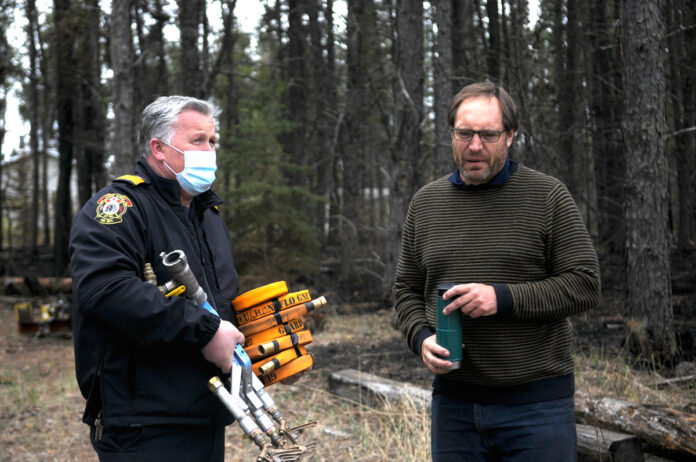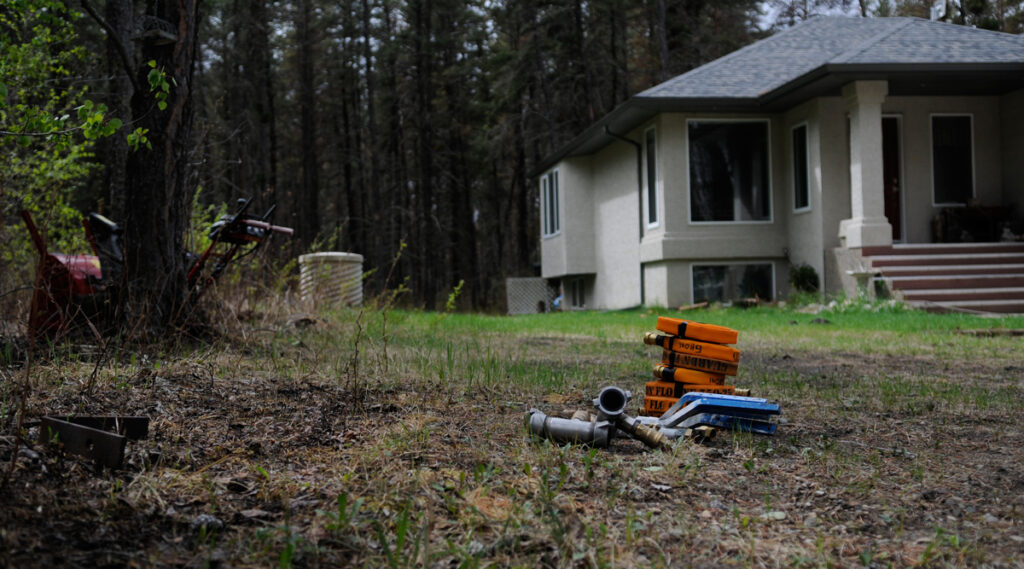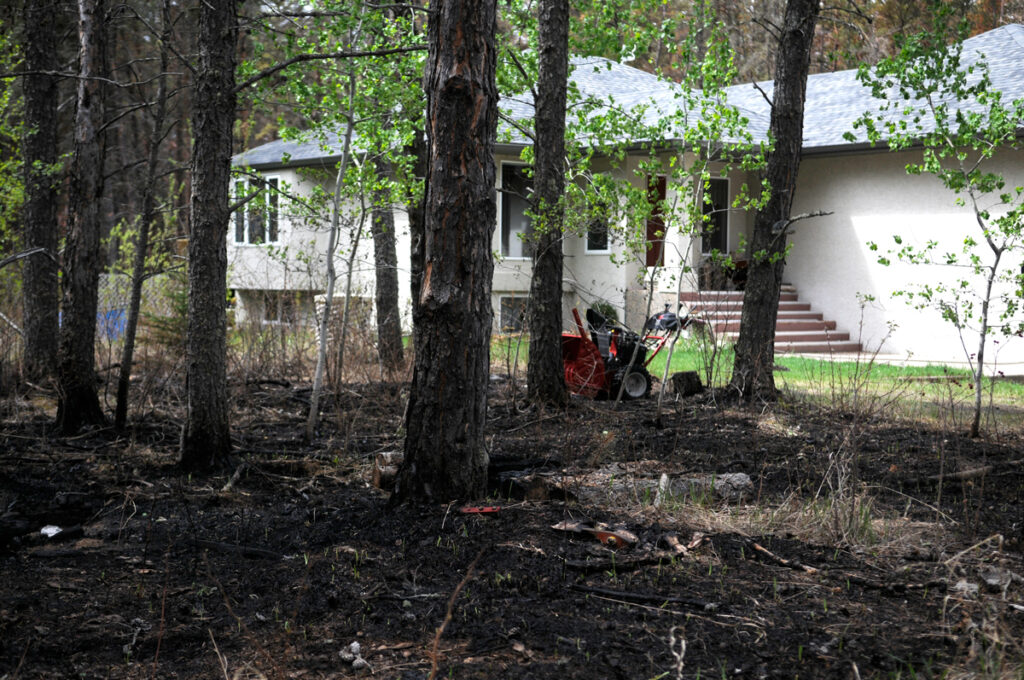
Kobus Steyn didn’t think there could be any possible way his Birch Lane home wasn’t consumed by the Cloverdale fire.
Steyn, an emergency room doctor and farmer, was working in the field in the Spruce Home area, about 25 km north of his home, when a text came in from a friend that a wildfire was threatening his home.
He returned with a trailer and started to save what he could. He thought he had an hour. He only had 20 minutes before the RCMP arrived to move him along.
As he left, he saw the firefighters racing the other way.
He ended up grabbing very little. A few mementos, but no clothes, and not even a toothbrush,
“You realize, when you look at the fire, ‘I’m not going to have any of that afterwards,’” he said.
He and his wife fled to Prince Albert Monday night. Steyn watched as planes filled with fire retardants and helicopters with Bambi buckets dropped their loads on the fire. Still, he said, nothing seemed to slow it down.
“I’m going to lose everything,” he remembers thinking to himself, and texting to his friends.
“It was the one thing that was very obvious.”
On Thursday, Steyn was allowed to return home. By then, news broke that no homes had been lost to the fire. Still, he wasn’t sure what he would return to.
As the Steyns drove back to their home, they saw the destruction left in the fire’s wake.
“If you’re driving here, right from before the turnoff onto Birch Lane, everything is burnt. You get onto Birch Lane, everything is burnt. You come around the corner and here’s you’re little house, perfect. Untouched. It almost feels surreal.”

Returning home to see just that – his home, undamaged by fire, his grass growing thick, lush and green on each side, giving way to scorched tree trunks and blackened soil, was “pretty emotional.”
The night he returned home, his neighbours did as well. No one else was allowed into the area, as the fire was still burning nearby. “Everyone went into the yards to see what (the damage was),” Steyn recalled.
“It was amazing. Everybody’s story was exactly the same. (They said) my house would have been gone.”
What saved Steyn, and all his neighbours, from returning to nothing was the hard work of the Prince Albert fire department and the use of rooftop sprinkler systems to keep the flames at bay.
Steyn welcomed Prince Albert Fire Chief Kris Olsen, along with members of the media, to his property Tuesday to highlight the importance of sprinklers, and to show off the difference the equipment made.
What saved his home, Steyn said, “by far, without a question, was the dedication of the firefighters. While we were running away from the fire, they ran toward it to put sprinklers on the roof.”
Steyn spoke to some of the firefighters. They stayed on scene as long as they had to, sheltering under his semi-trailer when the retardant and waterbombers came.
Then, he said, they got back out and continued manning the sprinkler system, even as the fire wrapped around his property. It came within ten metres of his front steps.
“The biggest contribution was the sprinkler system,” Steyn said.
“If you look right around my house, everything is burned and only this little patch my house is on is not burned and has no damage, because of the people soaking it with water from sprinklers.”
The benefit of sprinklers is demonstrated, Olsen said, by the saved structures on Birch Lane.

Rooftop sprinklers, he said, hook into specialized hoses that send water at a high PSI into the sprinklers, coating the area with water and preventing the fire from spreading. Olsen himself attended to Steyn’s home during the wildfire response and said a handful of overlapping systems kept the flames at bay.
There are about ten homes in the area, he said. To do the same job as a sprinkler system, each home would need its own crew and engine. The city only has five. Using fire engines would also tax the water supply in a way sprinklers don’t he said.
The sprinklers were attached to hoses and brought back to a single water supply. That supply was refilled by tankers and water haulers bringing water from the airport’s fire hydrant.
“I’ve got to say a big thank you to the custom water haulers who showed up and put in those long, long hours,” he said.
Olsen is encouraging anyone who lives north of the river or in a forested area to consider investing in rooftop sprinklers. Having a system of their own means firefighters spend less time setting one up, and more time saving other structures or containing the fire’s flank.
It’s not just a matter of making the property wet. Sprinklers also raise the area’s humidity, he said, taking the fight out of the fire.
“With the high temperatures, low humidity and increased winds, it made the (fire’s) southern flank quite aggressive and it burned through Birch Lane and parts of Evergreen as well,” Olsen said.
‘We were able to get those under control.”
Without sprinklers, which were purchased by the city back in 2016, “it would have been impossible,” Olsen said. “We couldn’t have done it.”
He encouraged residents considering rooftop sprinklers to reach out to local suppliers or to contact the fire department for more information.
While the sprinklers allowed firefighters to save those homes, Steyn also gives major thanks to the men and women who worked on the fire, some working up to 36 or 40 hours at a time.
He pointed to his snowblower, which is usually kept in the bush. Firefighters moved it to within range of the sprinklers. They did the same with a trailer used to store snowmachines, a task that would have required them to move it by hand. As a result, both were saved.
“I’ve got a new appreciation for firefighting,” Steyn said.
“You run away when they run in. (Everything) would have been gone if it wasn’t for the firefighters that went above and beyond what they were paid to do. All I can say is thank you, thank you, thank you. I would have had none of this.”
Sidebar: FireSmart your home
Olsen also spoke to the importance of using FireSmart principles to protect your home.
That includes using less flammable building materials for your siding and roof and cutting away any brush that can serve almost like a ladder, bringing fire from the forest to your front door.
The same goes for city residents, he added. With a rash of garbage fires, he said residents should store their garbage cans at least 3 metres from anything flammable, including their house.
That way, if they do catch fire, the likelihood of it spreading to your home or anything else on your property is minimal.
For more information about using FireSmart principles to protect your home or cottage, including using less-flammable building materials, visit firesmartcanada.ca.

